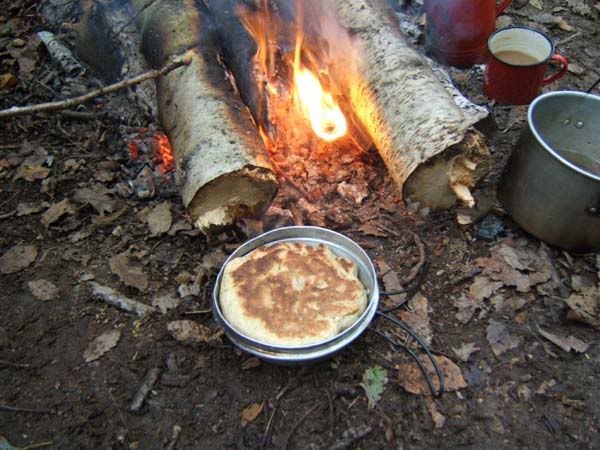Hi,
You must "knock back "the dough after the initial proving period. Otherwise the bread will be hard and not properly mature.
Speaking of baking bread in the field. If the weather is cold, just add extra yeast. This also goes for baking in the home during the different seasons.
I'll just tell you how I do mine. (in the home).
600mls of water at body temperature.(yeast will be killed at 60 deg c. If the water is cold, it will take much longer to rise);
1kg . flour. strong , preferably Canadian,
25gr fresh yeast.(British climate) For dried yeast use 1 third the amount of fresh,
salt.(optional). NB, never mix salt and yeast directly together.
Put flour on work top, and create hollow in the middle(volcano), pour in, gradually the water containing the yeast which you dissolve with your hand. Bit by bit, add the water whilst stirring gently with your fingers, until all the water is finished. Then work all the flour into the "mess"!, and start bringing it all together and you will eventually have a smooth dough and a clean work top. If, because of different flours, the dough is still really sticky, just add a bit more flour and vice versa if the it is too dry. It's best to have it on the wet side. Then make it in to a neat ball and place into a floured bowl and put it in the airing cupboard or similar. Or just leave it on the work top and place a few tea towells over it. Cover it up and leave it for 2 hours.
Then prepare your trays and flour them. Shape your dough however you want and place into the oven.Turn oven on for about a minute and then turn it off, to warm the oven a bit, and leave the bread for an hour. Then take the trays out, very carefully and put oven on to 250deg c or the highest setting. Only when the oven is hot, put the bread in, making sure to treat it gently so as not to deflate the dough.
If you want you can take a razor blade or razor sharp knife and make cuts over the top of the dough, but very gently. This will make a good crust and allow even cooking. If you have plant spray thing, fill it with clean water and as you put the bread in the oven, spray water at the sides of the oven to create steam and shut the quickly. The steam will make a good colour and give a good initial crust.
Don't open the door of the oven too soon as you'll ruin it. The cooking time depends on the shape of your bread and the quality of your oven.
This is a simple method, but there are many methods for different bread.
Julian.


 Both he and Lawrence were fooled until Juha actually picked it up.
Both he and Lawrence were fooled until Juha actually picked it up.